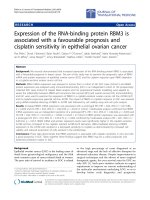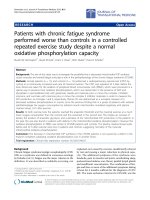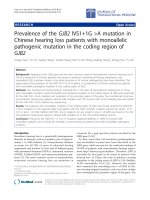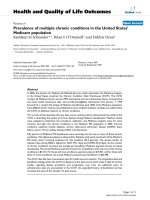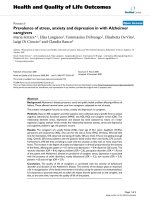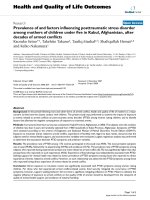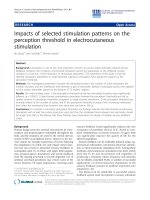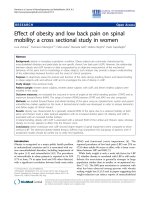báo cáo hóa học: " Prevalence of latent tuberculosis infection among health care workers in a hospital for pulmonary diseases" pptx
Bạn đang xem bản rút gọn của tài liệu. Xem và tải ngay bản đầy đủ của tài liệu tại đây (208.36 KB, 7 trang )
BioMed Central
Page 1 of 7
(page number not for citation purposes)
Journal of Occupational Medicine
and Toxicology
Open Access
Research
Prevalence of latent tuberculosis infection among health care
workers in a hospital for pulmonary diseases
Anja Schablon*
†1
, Gudrun Beckmann
†2
, Melanie Harling
†1
, Roland Diel
†3
and Albert Nienhaus
†1
Address:
1
Institution for Statutory Accident Insurance and Prevention in the Health and Welfare Services, Department of Occupational Health
Research, Pappelallee 35-37, 22089 Hamburg, Germany,
2
Hospital of Pulmonary Diseases Großhansdorf Hamburg, Germany and
3
School of
Pulbic Health, Institute of Medical Sociology, University of Düsseldorf, Germany
Email: Anja Schablon* - ; Gudrun Beckmann - ;
Melanie Harling - ; Roland Diel - ; Albert Nienhaus - albert.nienhaus@bgw-
online.de
* Corresponding author †Equal contributors
Abstract
Background: Little is known about the prevalence of latent tuberculosis infections (LTBI) in
health care workers (HCW) in low-incidence countries especially in hospitals for pulmonary
diseases. With Interferon-gamma release assays (IGRA), a new method for diagnosis of LTBI is
available which is more specific than the tuberculin skin test (TST).
Objectives: The study was designed to estimate prevalence of LTBI among 270 HCW in a
Hospital of Pulmonary Diseases routinely screened for TB.
Methods: LTBI was assessed by the QuantiFERON-Gold In Tube (QFT-IT). Information on
gender, age, workplace, job title, BCG vaccination and history of both TB and TST were collected
using a standardised questionnaire. Adjusted odds ratios for potential risk factors for LTBI were
calculated.
Results: The prevalence of LTBI was 7.2%. In HCW younger than 30 years LTBI prevalence was
3.5% and in those older than 50 years 22%. Physicians and nurses showed a higher prevalence rate
than other professions (10.8% to 4.5%). The putative risk factors for LTBI were age (>50 year OR
9.3, 95%CI 2.5–33.7), working as physicians/nurses (OR 3. 95%CI 1.2–10.4) and no previous TST
in medical history (OR 4.4, 95%CI 1.01–18.9) when compared to those with a negative TST.
Conclusion: Prevalence of LTBI assessed by QFT-IT is low, this indicates a low infection risk even
in hospitals for pulmonary diseases. No statement can be made regarding the occupational risk as
compared to the general population because there are no LTBI prevalence data from Germany
available. The higher LTBI prevalence rate in older HCWs might be due to the cohort effect or the
longer time at risk.
Published: 9 January 2009
Journal of Occupational Medicine and Toxicology 2009, 4:1 doi:10.1186/1745-6673-4-1
Received: 13 October 2008
Accepted: 9 January 2009
This article is available from: />© 2009 Schablon et al; licensee BioMed Central Ltd.
This is an Open Access article distributed under the terms of the Creative Commons Attribution License ( />),
which permits unrestricted use, distribution, and reproduction in any medium, provided the original work is properly cited.
Journal of Occupational Medicine and Toxicology 2009, 4:1 />Page 2 of 7
(page number not for citation purposes)
Background
Germany is a country that developed from a high tubercu-
losis incidence country to a low incidence country during
the last 50 years. Since the 1950s, the number of new
tuberculosis (TB) cases in Germany decreased from 9.064
newly diagnosed TB cases in the year 2000 (Federal
Department of Statistics, 2000) to 5.402 in 2006 [1].
The introduction of effective control and preventive meas-
ures against tuberculosis transmission, the advent of an
effective treatment for tuberculosis and the concurrent
long-term downwards trend of tuberculosis incidence
substantially decreased the occupational risk among
healthcare workers [2]. Currently, in industrialised coun-
tries such as Germany, occupational tuberculosis among
HCWs is re-emerging as an important public health issue,
because of the resurgence of tuberculosis epidemic in
former Soviet Union (NIS) states, the emergence of multi-
drug-resistant strains of mycobacteria especially in these
countries and increasing migration from exactly these
countries [3]. Furthermore, the occurrence of TB as a co-
infection to HIV especially in the US has resulted in a
flare-up of the discussions about this work-related infec-
tion risk and in the initiating of a large number of related
epidemiological studies [4]. In addition, molecular epide-
miological studies have shown that even in countries with
a low TB incidence, 30 to 40% of all cases are cases of
"newly transmitted TB" [5-7].
In high-income countries (HIC) relatively few LTBI preva-
lence surveys have been published since 1990. Findings
were consistent with earlier surveys in that the median
prevalence of positive TST was 24% with a range from 4%
to 46 [8]. So far, these conventional studies on prevalence
of LTBI in HCW used the TST and were thus hampered by
the low specificity of the TST and its cross-reactivity with
BCG and nontuberculous mycobacteria (NTM) infections
[9].
The M. tuberculosis-specific interferon-gamma (IFN-γ) -
based diagnostic tests may improve this situation [10-12].
Two IGRAs, Quantiferon-TB and the T-spot TB are now
commercially available. The third generation of the Quan-
tiferon test (Quantiferon
®
TB Gold In-Tube, QFT-IT) meas-
ures in vitro IFN-γ production by the T-cells during in vitro
stimulation with peptides of the M. tuberculosis-specific
antigens of the region of difference (RD-1) ESAT-6, CFP-
10 and TB7.7. These antigens are not shared by any of the
BCG vaccine strains nor by the more common species of
NTM (e.g. M. avium) [13-15]. Available evidence reviewed
elsewhere [12,13,16] suggests that these Interferon-γ
release assays have higher specificity and at least equal
sensitivity as the TST and are unaffected by previous BCG
vaccination and most NTM. Therefore this test reduces the
risk of LTBI overestimation due to cross-reactions with
BCG vaccination or exposure to environmental mycobac-
teria [16].
So far only few studies have investigated the prevalence of
LTBI in HCWs in low-incidence countries with the new in-
vitro tests [17-22]. These prevalence rates are much lower
than those assumed for German HCW so far [23].
Employees in hospitals for pulmonary diseases are among
those individuals who are routinely screened for TB as
stipulated by German OSH legislation [24]. It is assumed
that this occupational field bears an increased risk of M.
tuberculosis infection for the employees because their
institutions frequently treat TB patients [8].
Out of 247 hospital workers of a German Hospital for Pul-
monary Diseases in Großhansdorf on average 1 TB case
per year occurred in the 30 years from 1950 to 1979. Most
TB-cases appeared at medically technical professions
(31.3%) followed by doctors (23%), nurses (13.6%) and
other non medical professions. While for the general Ger-
man population a sharp decrease in TB incidence was
observed in this time period there was no significant
decrease in TB incidence in the hospital staff. According to
the authors this indicated a "strong, flowing source of
infection" [25]. This hospital is still the referral center for
TB treatment in Hamburg. Therefore we analyzed the
prevalence of LTBI in the staff of this hospital with the
QFT-IT in order to assess the strength of the "source of
infection" more than 25 years later.
Methods
Study design
We conducted a cross-sectional study in a hospital for pul-
monary disease in the northern part of Germany. The
clinic has three wards specialized in pneumology, pneu-
mology/oncology, and thoracic surgery, with a total
capacity of 213 beds. About 8,500 in-patients and 4,500
out-patients from all over Northern Germany are treated
each year. The clinic has 350 staff members (40 physi-
cians, 150 nurses, 80 employees in the areas of radiology,
pulmonary function, laboratory etc. plus 20 in anesthesia/
surgery. One of the treatment foci is tuberculosis. 60 TB
patients are treated per year, 95% of them presenting with
infectious pulmonary TB. Up to 10% of these TB-cases
were drug resistant, particularly MDR, and up to 3 cases
were multi drug resistant (XDR). 75% of the TB patients
treated per year are referred without a diagnosis or suspi-
cion of TB. Only 25% of the patients were already diag-
nosed or referred with the suspicion of TB. These patients
were isolated on arrival. The clinic has a special TB-ward
but no engineering controls such as ventilation and UV
light. The study population consisted of HCWs tested
between December 2005 and January 2008, either in the
course of a contact tracing or in serial testing of TB high-
Journal of Occupational Medicine and Toxicology 2009, 4:1 />Page 3 of 7
(page number not for citation purposes)
risk groups following German OSH legislation (Biost-
offverordnung). A total of 270 HCW were enrolled in the
study. There were no exclusion criteria for study partici-
pants.
Diagnostic methods
For the IGRA, the QuantiFERON-TB Gold In-Tube test was
used (Cellestis Limited, Carnegie, Australia). This whole-
blood assay uses overlapping peptides corresponding to
ESAT-6, CFP-10, and a portion of tuberculosis antigen
TB7.7 (Rv2654). Stimulation of the antigenic mixture
occurs within the tube used to collect the blood. Tubes
were incubated at 37°C overnight before centrifugation,
and INF-γ release was measured by ELISA following the
protocol of the manufacturer. All the assays performed
met the manufacturer's quality control standards. The test
was considered positive if INF-γ was ≥ 0.35 UI/ml after
correction for the negative control.
Questionnaire items
Information on the following variables was collected
using a standardized questionnaire: age, gender, reason
for testing, occupational exposure to TB, time of occupa-
tion in health care sector, reason for testing, family history
of TB, BCG vaccination, place of birth, prior TST, job title,
workplace and chest radiographic findings. BCG vaccina-
tion was verified by scars or vaccination records.
The study protocol was approved by the ethics committee
of the Hamburg Medical Council. All persons gave their
written informed consent prior to their inclusion in the
study.
Statistical analysis
Data analysis was performed using SPSS, Version 14 (SPSS
Inc., Chicago, Illinois). The study population comprises
270 HCWs, which means that more than two thirds of the
hospital staff were examined. Due to indeterminate QFT-
IT result 5 HCWs (1.9%) were excluded from the analysis.
Adjusted Odds ratios for QFT-IT depending on different
putative predictive variables were calculated using logistic
regression. Model building was performed backwards
using the chance criteria for variable selection [26].
Results
The mean age of the participants was 34.7 ± 12.6 years.
The majority of the participating HCWs (74%) were
female and the mean age was 34.7 years (SD ± 12.6). A
history of BCG vaccination was recorded for 52.8% of the
participants. 19.2% of the study population were born
outside Germany or had a history of migration and 80.2%
of the study population were born in Germany (table 1).
Most of the foreign-born participants came from Turkey,
former Soviet Union (NIS) states and Eastern Europe, e.g.
Poland and Bulgaria. 25.5% of the employees with a his-
tory of migration were physicians or nurses. The vast
majority worked in non-medical areas, for example as
cleaners (56.9%). None of the foreign-born physicians/
nurses was QFT-IT positive (no table).
35.5% of the total study population were nurses, 6.4%
physicans and 58.1% were other professions in health
care sector or non-medical staff including cleaners, trans-
portation service staff, physiotherapists, interns, radiology
staff, conscientious objectors, apprentices and administra-
tive staff. In the subgroup other professions only two per-
Table 1: Description of the study population
Variable N %
Gender
Female 196 74
Male 69 26
Age*
< 30 years 115 43.4
30 – < 40 years 41 15.5
40 – < 50 years 68 25.7
50 – 67 years 41 15.5
Country of birth
Germany 214 80.8
foreign country 51 19.2
BCG-vaccination
No 125 47.2
Yes 140 52.8
TST history
No TST in medical history 33 12.5
Negative TST in history 151 57
Positive TST in history 81 30.6
Job category
Nurse 94 35.5
Physician 17 6.4
Other professions 154 58.1
QFT-IT
Negative 246 92.8
Positive 19 7.2
Workplace
Admission ward 18 6.8
Infection ward 110 41.5
Other 137 51.7
Reason for testing
Serial examination 246 92,8
Contact tracing 19 7,2
Total 265 100
* mean age 34.7, standard deviation 12.6
Journal of Occupational Medicine and Toxicology 2009, 4:1 />Page 4 of 7
(page number not for citation purposes)
sons with direct patient contact (one physiotherapist and
one radiology staff member) are included. These two per-
sons were positive by QFT-IT but either 5 cleaners and
administrative staff members were QFT-IT positive (data
not shown). 92,8% (n = 246) of the HWCs were investi-
gated because of serial examinations of high risk groups
following the German OSH legislation (Biostoffverord-
nung) and 19 (7,2%) of these participants were positive
by QFT-IT. 19 HCWs were investigated in course of con-
tract tracing but nobody in these group was positive by
QFT-IT (table 1).
A positive QFT-IT result was observed in 19 (7.2%) partic-
ipants and 81 participants reported a positive previous
TST (table 1). Out of 33 participants with no TST in their
medical history, 4 persons (12,1%) were now positive by
QFT-IT (TB-antigen-Nil range from 0,44 to 1,50). Of the
81 participants positive in a previous TST, 10 (12.3%)
were confirmed by the IGRA (TB-antigen-Nil range from
0,46 to 270,2)(no table).
The prevalence of LTBI assessed by QFT-IT correlated with
age. In the subgroup with participants under 30 years old,
LTBI prevalence was 3.5%. In the subgroup with partici-
pants between 50–67 years the prevalence increased to
22%. LTBI prevalence was higher in physicians and nurses
(10.8%) than in other areas of occupation (4,5%) within
the hospital. In the wards of pulmonology/Infectious dis-
eases, QFT-IT was less often positive than in the admission
ward (3.6 versus 11%). However, the differences were not
statistically significant (table 1).
The putative risk factors for a positive QFT-IT were age
(>50 year OR 7.7, 95%CI 2.1–28.2) and working as a phy-
sician/nurse (OR 3.2, 95%CI 1.1–9.0). Using the sub-
group with a negative TST in history as comparison group,
the odds ratio for those with no previous TST in medical
history was elevated (OR 4.4, 95%CI 1.01–18.9). The lat-
ter statistically significant association was observed after
adjustment for age and job category, it did not show in the
crude data. No statistically significant association was
observed for gender, BCG vaccination, workplace and
migration (Table 2).
All participants with a positive QFT-IT were offered a clin-
ical and radiologic examination to rule out active TB.
None of them showed any clinical or radiological sign of
active TB disease and hence no further action was taken.
Discussion
In this study, we have found that the prevalence of LTBI
assessed by QFT-IT is low and it is considerably lower than
assumed in the past [23]. With the IGRA we have, for the
first time, a test that allows for valid statements regarding
the LTBI prevalence, infection risk and disease probabil-
ity.
Only few studies in low-incidence countries have so far
employed the IGRA as a screening instrument in health
care workers [17-22]. In accordance with the literature,
Nienhaus et al. investigated 261 HCWs from different
types of hospitals who are routinely screened for TB as
stipulated by German OSH legislation using QFT-IT and
TST following the German Guidelines with a cut off >5
mm. LTBI prevalence assessed by QFT-IT was 9.6% com-
pared to 24.1% with TST [17]. Furthermore, Soborg and
colleagues used QFT-Gold TB to test 139 HCWs at two
departments for infectious diseases in Copenhagen. 105
HCW had direct patients contact and 34 HCW were
employed with office work and had no daily patient con-
tact. They found an LTBI prevalence rate of only 1% (n =
2) as compared to 34% (n = 47) with the TST (cut off >12
mm); and this rate was much lower than the estimated
prevalence (7.2%) in our study [18]. Stebler et al. also
studied the prevalence of LTBI among hospital employees
at the University Hospital of Berne using the IGRA. A total
of 777 HCWs were investigated. A positive IGRA was
found for 59 (7,6%) [22]. In addition Harada et al. inves-
tigated the performance of the QFT-G for detecting LTBI
by testing 332 HCWs in a Japanese general hospital and
suggested a prevalence of LTBI of 9.9% [19]. Kobashi and
colleagues found a prevalence of LTBI of 3% among 109
HCWs who were examined during contact investigations
[20]. In the study among 95 HCWs working in depart-
ments of radiology, Barsegian et al. observed a prevalence
of LTBI of 1% using the T-SPOT in 95 German radiologists
[21].
The relatively low rate of positive QFT-IT we found in
HCWs in a German hospital for pulmonary diseases indi-
cates a low infection risk even in this occupational area.
Especially in working fields with an increased risk of TB
exposure, effective control measures are an important tool
to reduce TB transmission. Because TB treatment is one of
the focus areas of hospitals for pulmonary diseases, it can
be assumed that physicians and nurses are familiar with
the appropriate protective measures. As patients are
referred to the clinic after some clinical evaluation else-
where, TB cases may be identified early or even before
referral and effective control measures may be taken.
In this study, we found no indication for a "strong, flow-
ing source of infection". From 1950 to 1979 a total of 29
employees of the Pulmonary Hospital of Großhansdorf
developed active TB while the overall TB incidence in the
general population was decreasing. The authors con-
cluded that the staff of this hospital was exposed to a
greater risk than the population of Germany or other
Journal of Occupational Medicine and Toxicology 2009, 4:1 />Page 5 of 7
(page number not for citation purposes)
industrialized countries [25]. In the scope of the present
examination, none of the employees developed active TB
in the observation time of 1 year. Only 7.2% of the
employees were QFT-IT positive. This may indicate further
improvement of the TB control measures.
In contrast to our findings, three molecular biological
studies have found a job-related exposure to TB for HCWs.
First, a molecular biological fingerprint study from Ham-
burg/Germany (n = 848) has shown that the risk of active
TB for HCWs is not increased as compared to the general
population. However when disease occurred, the infec-
tion is most probably due to job-related exposure. In the
Hamburg fingerprint study, a total of 10 HCWs developed
TB; a job-related infection was established in 8 of them
(80%) [5]. Second, Ong et al. [6] failed to detect an
increased TB rate among HCWs in San Francisco in their
fingerprint study (n = 2510). The proportion of clustered
Table 2: Frequency and Adjusted Odds ratios (OR) and 95% Confidence Interval (95%CI) for Covariates associated with QFT-IT
Results.
QFT-IT
Characteristics negative
N (%)
positive
N (%)
Odds Ratio 95% CI
Gender**
female 182 (92.9%) 14 (7.1) 1
male 64 (92.8) 5 (7.2) 1.3 0.4–4.2
Age*
>30 years 111 (96.5) 4 (3.5) 1
30–40 years 39 (95.1) 2 (4.9) 1.2 0.2–7.0
40–50 years 64 (94.1) 4 (5.9) 1.5 0.4–6.5
50–67 years 32 (78.0) 9 (22.0) 7.7 2.1–28.2
Country of birth**
Germany 198 (92.5) 16 (7.5) 1
foreign born 48 (94.1) 3 (5.9) 0.9 0,2–3,3
Job Category*
other professions 147 (95.5) 7 (4.5) 1
physician/nurse 99 (89.2) 12 (10.8) 3.2* 1.1–9.0
BCG vaccination**
no 114 (91.2) 11 (8.8) 1
yes 132 (94.3) 8 (5.7) 0.5 0.2–1.3
TST history*
negative TST in history 146 (96.7) 5 (3.3) 1
no TST in medical history 29 (87.9) 4 (12.1) 4.4 1.01–18.9
positive TST in history 71 (87.7) 10 (12.3) 3.0 0.95–9.6
Workplace**
other 124 (90.5) 13 (9.5) 1
admission ward 16 (88.9) 2 (11.1) 1,4 0.3–79.2
infection ward/pulmology 106 (96.4) 4 (3.6) 0,4 0.1–1.3
* the final multivariate logistic regression model contains the variable age, job category and TST history.
** adjusted Odds ratio for age, job category and TST history.
Journal of Occupational Medicine and Toxicology 2009, 4:1 />Page 6 of 7
(page number not for citation purposes)
cases in HCWs (32%) was similar to that observed in the
community (36%). In at least 10 (32%) of the HCWs,
there was genotyping and/or epidemiogical evidence of
job-related transmission [6]. Third, the objective of the
epidemiological and microbiological study of de Vries et
al. was to determine which TB cases among HCWs in the
Netherlands were infected during work. Of a total of 101
TB cases, the infection pathways of 67 cases could be
established; 42% (28 out of 67) were due to infection at
work [7].
In our study a positive QFT-IT result was associated with
age (>30 years 3.5%, 50–67 years 22%), no previous TST
in the medical history and occupation as a physician or
nurse. The higher prevalence rate in older HCWs might be
due to a cohort effect or the longer time at risk. HCWs
without a previous TST in their history had an increased
OR compared to those with a negative TST in history even
after controlling for risk of infection. A clear explanation
to this was not found. Probably those with a negative TST
once in history might be genetically protected against
infection. HCWs with an earlier positive TST also had an
increased OR which was, however, not statistically signif-
icant. This may be due to the small size of the group. A
booster phenomenon when IGRA are applied after TST
can be excluded because the QFT-IT was carried out in
front of the TST.
In the recent review from Menzies et al. [8] occupational
risk factors were associated with work in internal or respi-
ratory medicine, years of work in healthcare, more direct
indicators of TB exposure, including TB admission or the
percentage of patients with TB or HIV cared for [8].
Another reason for transmission in healthcare settings was
the delayed diagnosis of the index case, especially in eld-
erly patients. In the HCW study by De Vries et al. 44% of
the index patients were older than 60 years. Delayed diag-
nosis in older patients was the main cause of patient-to-
HCW transmission in the Netherlands [7].
So far the occupational LTBI infection risk of nurses has
been investigated in several conventional studies. Most
studies showed a statistically significant increase of >2 in
relative risk [27]. The infection risk of physicians was
examined in various studies of varying quality. Because of
the inadequate data, it is difficult to evaluate the tubercu-
losis risk in different medical specialties. The results are
contradictory and all in all do not indicate an increased
infection risk for physicians. Pathologists have an
increased risk of infection but no pathologist were
included in this study. Several studies also identified a sta-
tistically clearly increased TB infection risk of the staff of
wards where TB patients are treated; thus the increased
infection risk of HCWs in areas with TB patients is epide-
miologically ascertained [27].
The IGRAs proves to be a more important screening
instrument for LTBI diagnosis in low-incidence countries
as it allows valid statements on the prevalence and inci-
dence of LTBI. The IGRA can help to identify at-risk
groups and reduce the indication of preventive chemo-
therapy. The use of IGRAs in serial testing of health care
workers is still not very well studied and the influence of
the role of potential dynamic of IGRA responses still
needs to be clarified [28]. Most of the serial testing studies
have been done in high-incidence countries and show
inconsistent results. Very few studies so far have been
done on disease progression [29,30]. The data indicate
that a positive IGRA correlate with a high progression rate
but the number of cases is still small and these results
need to be interpreted with care. The recent study from
Diel et al. (2008) on disease probability after positive
IGRA showed that, out of 41 participants with a positive
IGRA result, 14.6% developed TB within the 103 weeks of
observation. The progression rate for TST-positives was
only 2.3% [29]. Thus the progression rate estimated by
IGRA was higher than the one estimated by WHO [31] for
lifetime after positive TST (5 to 10%).
Limitations
As changes with time cannot be considered in a cross-sec-
tional study, the OR can provide evidence for factors influ-
encing the results, but only restricted conclusions about
the causality of these correlations are possible. To allow
for a comparison between professions under risk we cre-
ated a variable with the groups Nurse, Physician and other
professions (reference group). It was known, that in the
unexposed group might also be employees with contact to
patients (e.g. physiotherapist and radiology staff), but
there was only two case of QFT-IT positive. This may limit
the generalizability of our results.
Conclusion
In summary, the prevalence of LTBI assessed by QFT-IT in
a hospital for pulmonary diseases is rather low. Other
than in the years before 1980, we found no indication for
a "strong, flowing source of infection". No statement can
be made regarding the occupational risk as compared to
the general population because there are no data from
Germany available for comparison. It is important, espe-
cially in high-risk settings, to follow the current guidelines
for the prevention of tuberculosis in the workplace,
including appropriate patient risk assessment, active hos-
pital tuberculosis case surveillance and development of an
effective institutional infection control plan to reduce the
transmission rate of tuberculosis in healthcare settings [6-
8]. Disease probability in HCWs tested positive by serial
testing should be investigated in longitudinal studies
Competing interests
The authors declare that they have no competing interests.
Journal of Occupational Medicine and Toxicology 2009, 4:1 />Page 7 of 7
(page number not for citation purposes)
Authors' contributions
GB has made substantial contributions to acquisition of
data. She has been involved in revising it critically for
important intellectual content.
RD has made substantial contributions to conception and
design of the study. He has been involved in revising the
manuscript critically for important intellectual content,
MH has made substantial contributions to interpretation
of data. She has been involved in revising the manuscript
critically for important intellectual content.
AN has made substantial contributions to conception and
design, as well as to analysis and interpretation of data. He
has been involved in drafting the manuscript
AS has made substantial contributions to conception and
design, acquisition of data, as well as to analysis and inter-
pretation of data. She has been involved in drafting the
manuscript
Acknowledgements
We wish to express your gratefulness to the HCW, who participated in the
study. The study was fully paid for by the Institution for Statutory Accident
Insurance and Prevention in the Health and Welfare Services.
References
1. Brodhun B, Altmann D, Haas W: Report for the epidemiology of
the tuberculosis in Germany 2006 RKI. editor. 12-3-2008. Berlin.
German .
2. Baussano I, Bugiani M, Carosso A, Mairano D, Barocelli AP, Tagna M,
Cascio V, Piccioni P, Arossa W: Risk of tuberculin conversion
among health care workers and the adoption of preventive
measures. Occup Environ Med 2007, 64:161-6.
3. Loddenkemper R, Sagebiel D, Brendel A: Strategies against multi-
drug-resistant tuberculosis. Eur Respir J Suppl 2002, 36:66s-77s.
4. Menzies D, Fanning A, Yuan L, Fitzgerald M: Tuberculosis among
health care workers. N Engl J Med 1995, 332:92-98.
5. Diel R, Schneider S, Meywald-Walter K, Ruf CM, Rusch-Gerdes S,
Niemann S: Epidemiology of tuberculosis in Hamburg, Ger-
many: long-term population-based analysis applying classical
and molecular epidemiological techniques. J Clin Microbiol
2002, 40:532-539.
6. Ong A, Rudoy I, Gonzalez LC, Creasman J, Kawamura LM, Daley CL:
Tuberculosis in healthcare workers: a molecular epidemio-
logic study in San Francisco. Infect Control Hosp Epidemiol 2006,
27:453-458.
7. De Vries G, Sebek MM, Lambregts-van Weezenbeek CS: Health-
care workers with tuberculosis infected during work. Eur
Respir J 2006, 28:1216-1221.
8. Menzies D, Joshi R, Pai M: Risk of tuberculosis infection and dis-
ease associated with work in health care settings. Int J Tuberc
Lung Dis 2007, 11:593-605.
9. Menzies D: What does tuberculin reactivity after bacille Cal-
mette-Guerin vaccination tell us? Clin Infect Dis 2000, 31(Suppl
3):S71-S74.
10. Pai M, Kalantri S, Dheda K: New tools and emerging technolo-
gies for the diagnosis of tuberculosis: part I. Latent tubercu-
losis. Expert Rev Mol Diagn 2006, 6:413-422.
11. Nahid P, Pai M, Hopewell PC: Advances in the diagnosis and
treatment of tuberculosis. Proc Am Thorac Soc 2006, 3:
103-110.
12. Menzies D, Pai M, Comstock G: Meta-analysis: new tests for the
diagnosis of latent tuberculosis infection: areas of uncer-
tainty and recommendations for research. Ann Intern Med
2007, 146:340-354.
13. Andersen P, Munk ME, Pollock JM, Doherty TM: Specific immune-
based diagnosis of tuberculosis. Lancet 2000, 356:1099-1104.
14. Mahairas GG, Sabo PJ, Hickey MJ, Singh DC, Stover CK: Molecular
analysis of genetic differences between Mycobacterium
bovis BCG and virulent M. bovis. J Bacteriol 1996,
178:1274-1282.
15. Pai M: Alternatives to the tuberculin skin test: interferon-
gamma assays in the diagnosis of mycobacterium tuberculo-
sis infection. Indian J Med Microbiol 2005, 23:151-158.
16. Nienhaus A, Loddenkemper R, Hauer B, Wolf N, Diel R: Latent
tuberculosis infection in healthcare workers – evaluation of
an Interferon-gamma release assay. Pneumologie 2007,
61:219-223. German
17. Nienhaus A, Schablon A, Siano B, le Bacle C, Diel R: Evaluation of
the Interferon-gamma Release Assay in Healthcare Work-
ers. Int Arch Occup Enviro Health 2008, 81:295-300.
18. Soborg B, Andersen AB, Larsen HK, Weldingh K, Andersen P, Kofoed
K, Ravn P: Detecting a low prevalence of latent tuberculosis
among health care workers in Denmark detected by M.
tuberculosis specific IFN-gamma whole-blood test. Scand J
Infect Dis 2007, 39:554-559.
19. Harada N, Nakajima Y, Higuchi K, Sekiya Y, Rothel J, Mori T: Screen-
ing for tuberculosis infection using whole-blood interferon-
gamma and Mantoux testing among Japanese healthcare
workers. Infect Control Hosp Epidemiol 2006, 27:442-448.
20. Kobashi Y, Obase Y, Fukuda M, Yoshida K, Miyashita N, Fujii M, Oka
M: Usefulness of QuantiFERON TB-2G, a diagnostic method
for latent tuberculosis infection, in a contact investigation of
health care workers. Intern Med 2007, 46:1543-1549.
21. Barsegian V, Mathias KD, Wrighton-Smith P, Grosse-Wilde H, Linde-
mann M: Prevalence of latent tuberculosis infection in Ger-
man radiologists. J Hosp Infect 2008, 69:69-76.
22. Stebler A, Iseli P, Mühlemann K, Bodmer T: Whole-Blood Inter-
feron-Gamma Release Assay for baseline tuberculosis
screening of Healthcare Workers at a Swiss University Hos-
pital. Infect Control Hosp Epidemiol 2008, 29(7):681-683.
23. Kralj N, Hofmann F, Michaelis M: To the methodology of the
tuberculosis early diagnosis at work medical preventive
medical checkups in the public health service. Arbeitsmed
Sozialmed Umweltmed 1997, 32:50-54. German
24. Guidelines for Occupational Medical Examination – Prophy-
laxis in Occupational Medicine. 4th edition. Stuttgart, Gentner
Verlag; 2007.
25. Schumacher I, Sommerwerck D: Tuberculosis as occupational
disease – staff illnesses in a lung clinic over 30 years. Prax Pneu-
mol 1981, 35:603-605. German
26. Hosmer D, Lemeshow S: Applied logistic regression 2nd edition. New
York, Wiley & Sons; 2000.
27. Seidler A, Nienhaus A, Diel R: Review of epidemiological studies
on the occupational risk of tuberculosis in low-incidence
areas. Respiration 2005, 72:431-446.
28. Pai M, O'Brien R: Serial testing for tuberculosis: Can we make
sense of T cell assay conversions and reversions? PloS Medicine
2007, 4:e208.
29. Diel R, Loddenkemper R, Meywald-Walter K, Niemann S, Nienhaus
A: Predictive value of a whole-blood IFN-{gamma} assay for
the development of active TB disease. Am J Respir Crit Care Med
2008, 177:1164-1170.
30. Doherty TM, Demissie A, Olobo J, Wolday D, Britton S, Eguale T,
Ravn P, Andersen P: Immune responses to the Mycobacterium
tuberculosis-specific antigen ESAT-6 signal subclinical infec-
tion among contacts of tuberculosis patients. J Clin Microbiol
2002, 40:704-706.
31. Stop TB Partnership, World Health Organisation: Global Plan to
Stop TB 2006–2015 – Actions for life, towards a world free of
tuberculosis. Int J Tuberc Lung Dis 2006, 10(3):240-241.


